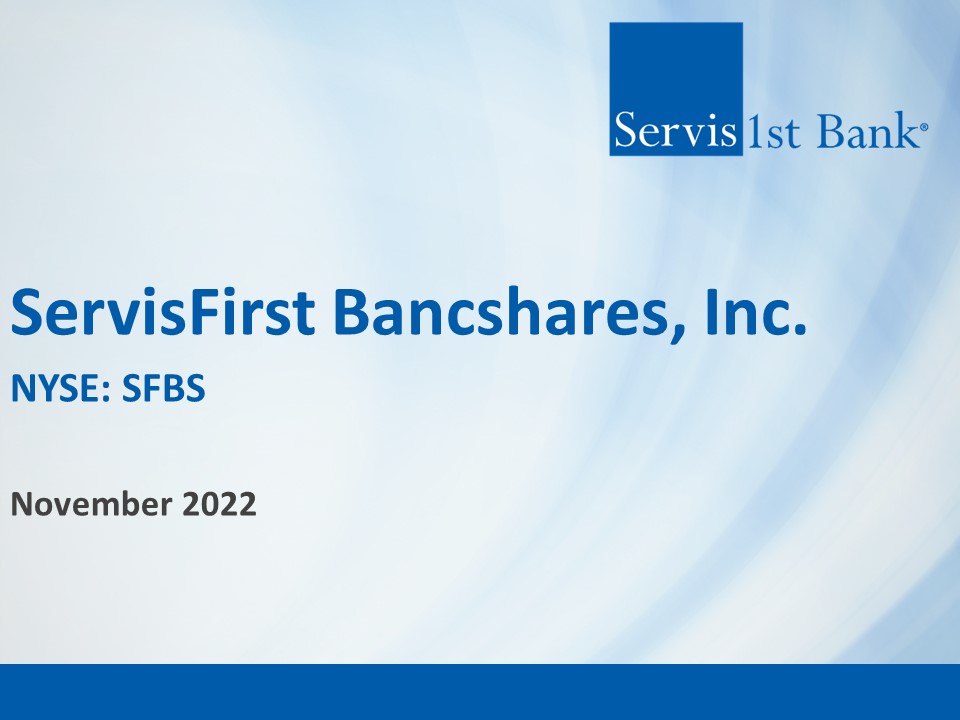
ServisFirst Bancshares, Inc. NYSE: SFBS November 2022
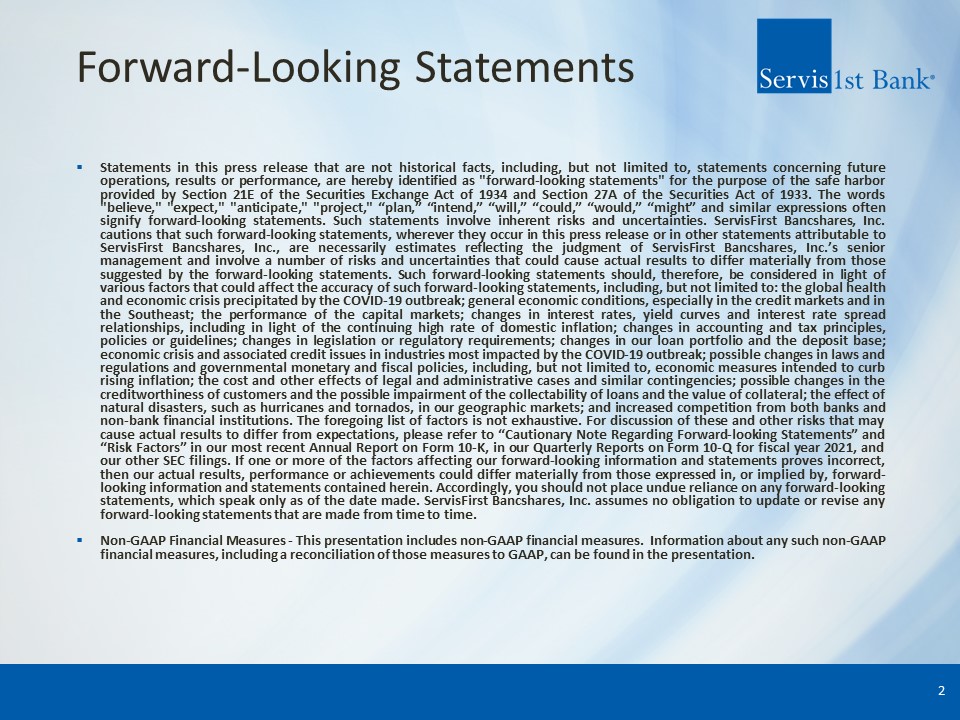
Forward-Looking Statements Statements in this press release that are not historical facts, including,
but not limited to, statements concerning future operations, results or performance, are hereby identified as "forward-looking statements" for the purpose of the safe harbor provided by Section 21E of the Securities Exchange Act of 1934 and
Section 27A of the Securities Act of 1933. The words "believe," "expect," "anticipate," "project," “plan,” “intend,” “will,” “could,” “would,” “might” and similar expressions often signify forward-looking statements. Such statements involve
inherent risks and uncertainties. ServisFirst Bancshares, Inc. cautions that such forward-looking statements, wherever they occur in this press release or in other statements attributable to ServisFirst Bancshares, Inc., are necessarily
estimates reflecting the judgment of ServisFirst Bancshares, Inc.’s senior management and involve a number of risks and uncertainties that could cause actual results to differ materially from those suggested by the forward-looking statements.
Such forward-looking statements should, therefore, be considered in light of various factors that could affect the accuracy of such forward-looking statements, including, but not limited to: the global health and economic crisis precipitated
by the COVID-19 outbreak; general economic conditions, especially in the credit markets and in the Southeast; the performance of the capital markets; changes in interest rates, yield curves and interest rate spread relationships, including in
light of the continuing high rate of domestic inflation; changes in accounting and tax principles, policies or guidelines; changes in legislation or regulatory requirements; changes in our loan portfolio and the deposit base; economic crisis
and associated credit issues in industries most impacted by the COVID-19 outbreak; possible changes in laws and regulations and governmental monetary and fiscal policies, including, but not limited to, economic measures intended to curb
rising inflation; the cost and other effects of legal and administrative cases and similar contingencies; possible changes in the creditworthiness of customers and the possible impairment of the collectability of loans and the value of
collateral; the effect of natural disasters, such as hurricanes and tornados, in our geographic markets; and increased competition from both banks and non-bank financial institutions. The foregoing list of factors is not exhaustive. For
discussion of these and other risks that may cause actual results to differ from expectations, please refer to “Cautionary Note Regarding Forward-looking Statements” and “Risk Factors” in our most recent Annual Report on Form 10-K, in our
Quarterly Reports on Form 10-Q for fiscal year 2021, and our other SEC filings. If one or more of the factors affecting our forward-looking information and statements proves incorrect, then our actual results, performance or achievements
could differ materially from those expressed in, or implied by, forward-looking information and statements contained herein. Accordingly, you should not place undue reliance on any forward-looking statements, which speak only as of the date
made. ServisFirst Bancshares, Inc. assumes no obligation to update or revise any forward-looking statements that are made from time to time. Non-GAAP Financial Measures - This presentation includes non-GAAP financial measures. Information
about any such non-GAAP financial measures, including a reconciliation of those measures to GAAP, can be found in the presentation. 2
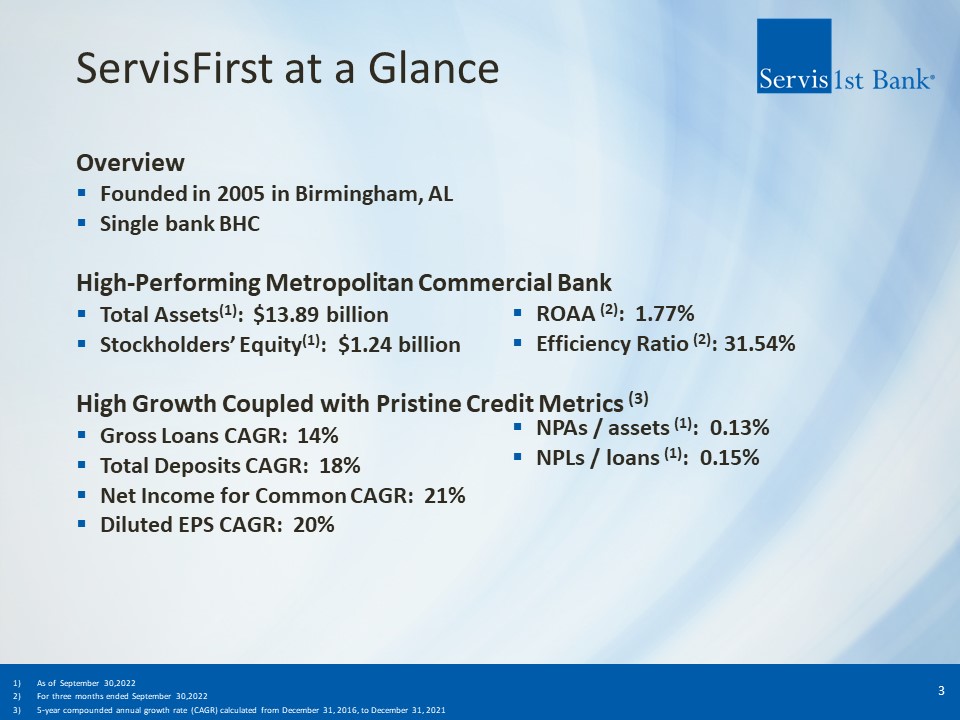
ServisFirst at a Glance Overview Founded in 2005 in Birmingham, AL Single bank BHC High-Performing
Metropolitan Commercial Bank Total Assets(1): $13.89 billion Stockholders’ Equity(1): $1.24 billion High Growth Coupled with Pristine Credit Metrics (3) Gross Loans CAGR: 14% Total Deposits CAGR: 18% Net Income for Common CAGR:
21% Diluted EPS CAGR: 20% ROAA (2): 1.77% Efficiency Ratio (2): 31.54% As of September 30,2022 For three months ended September 30,2022 5-year compounded annual growth rate (CAGR) calculated from December 31, 2016, to December 31,
2021 NPAs / assets (1): 0.13% NPLs / loans (1): 0.15% 3
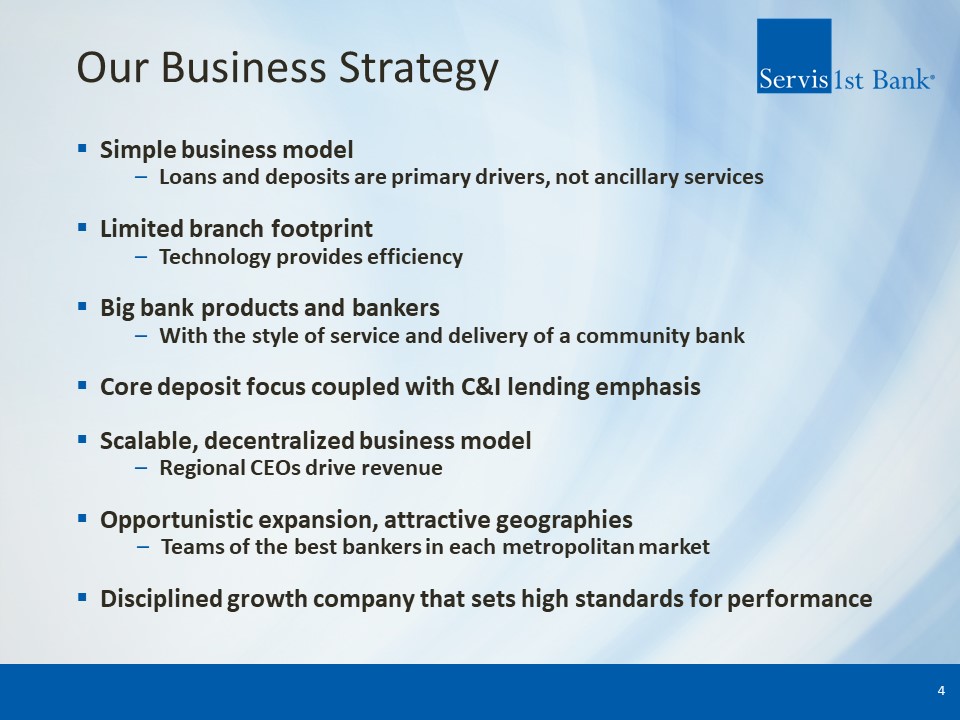
Our Business Strategy Simple business model Loans and deposits are primary drivers, not ancillary
services Limited branch footprint Technology provides efficiency Big bank products and bankers With the style of service and delivery of a community bank Core deposit focus coupled with C&I lending emphasis Scalable, decentralized
business model Regional CEOs drive revenue Opportunistic expansion, attractive geographies Teams of the best bankers in each metropolitan market Disciplined growth company that sets high standards for performance 4
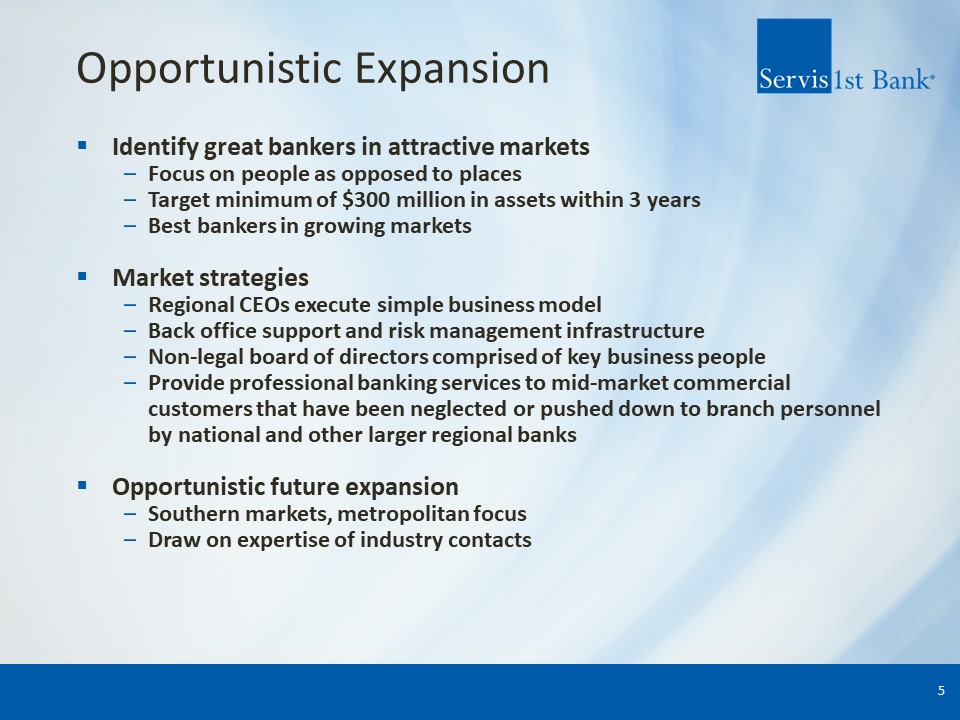
Opportunistic Expansion Identify great bankers in attractive markets Focus on people as opposed to
places Target minimum of $300 million in assets within 3 years Best bankers in growing markets Market strategies Regional CEOs execute simple business model Back office support and risk management infrastructure Non-legal board of
directors comprised of key business people Provide professional banking services to mid-market commercial customers that have been neglected or pushed down to branch personnel by national and other larger regional banks Opportunistic future
expansion Southern markets, metropolitan focus Draw on expertise of industry contacts 5
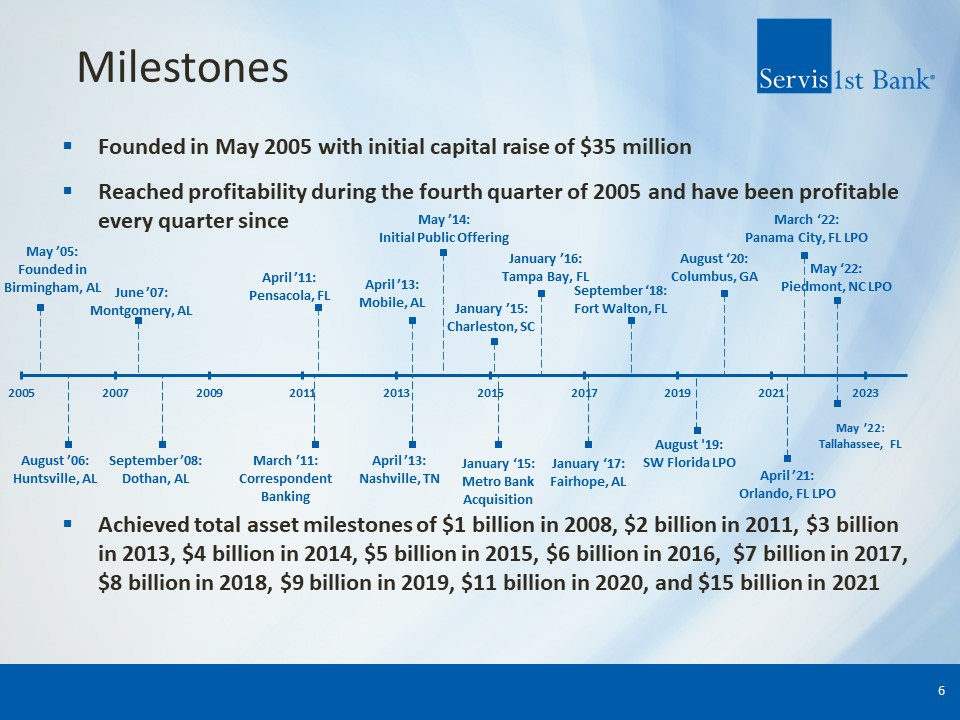
Milestones 6 Founded in May 2005 with initial capital raise of $35 million Reached profitability
during the fourth quarter of 2005 and have been profitable every quarter since Achieved total asset milestones of $1 billion in 2008, $2 billion in 2011, $3 billion in 2013, $4 billion in 2014, $5 billion in 2015, $6 billion in 2016, $7
billion in 2017, $8 billion in 2018, $9 billion in 2019, $11 billion in 2020, and $15 billion in 2021
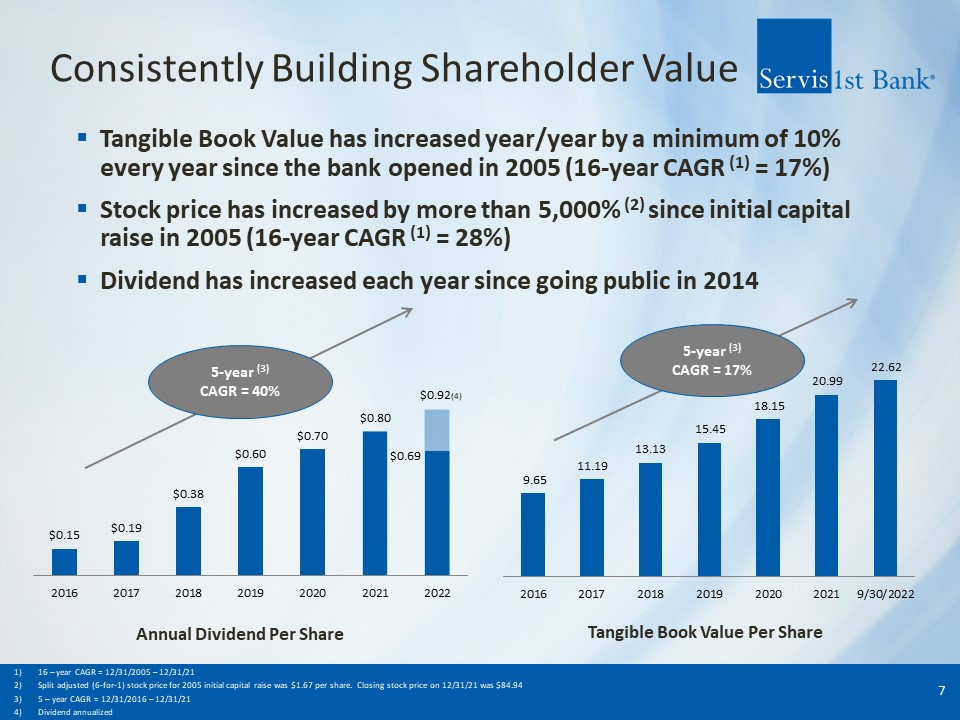
Consistently Building Shareholder Value Tangible Book Value has increased year/year by a minimum of
10% every year since the bank opened in 2005 (16-year CAGR (1) = 17%) Stock price has increased by more than 5,000% (2) since initial capital raise in 2005 (16-year CAGR (1) = 28%) Dividend has increased each year since going public in
2014 7 5-year (3) CAGR = 40% 5-year (3) CAGR = 17% Annual Dividend Per Share Tangible Book Value Per Share 16 – year CAGR = 12/31/2005 – 12/31/21 Split adjusted (6-for-1) stock price for 2005 initial capital raise was $1.67 per
share. Closing stock price on 12/31/21 was $84.94 5 – year CAGR = 12/31/2016 – 12/31/21 Dividend annualized
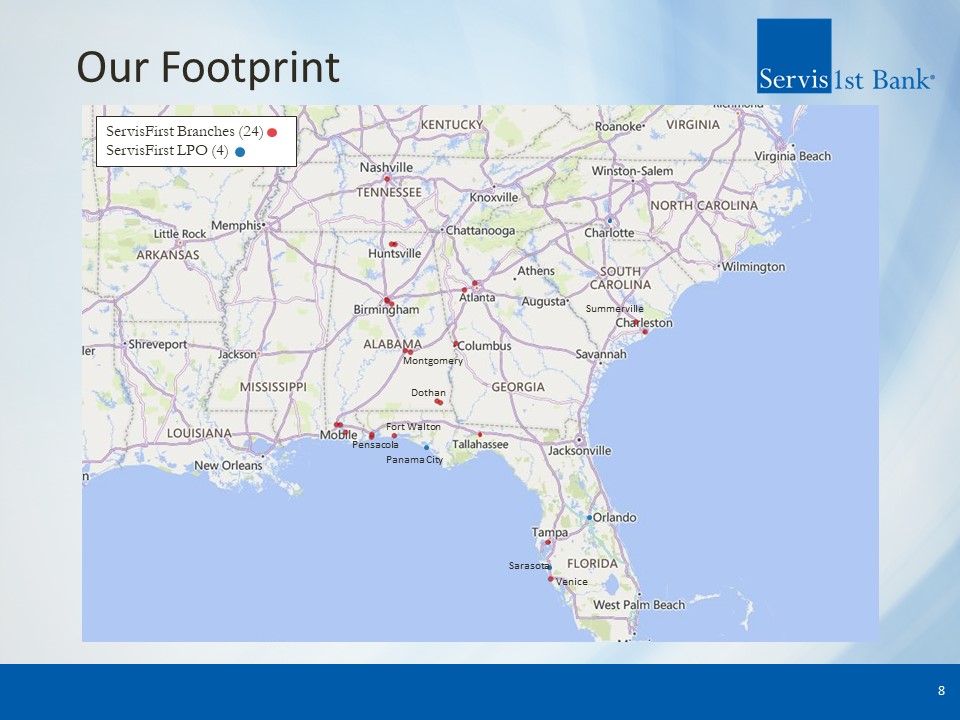
Our Footprint 8 ServisFirst Branches (24) ServisFirst LPO (4) Panama
City Summerville Venice Sarasota Fort Walton Pensacola Dothan Montgomery
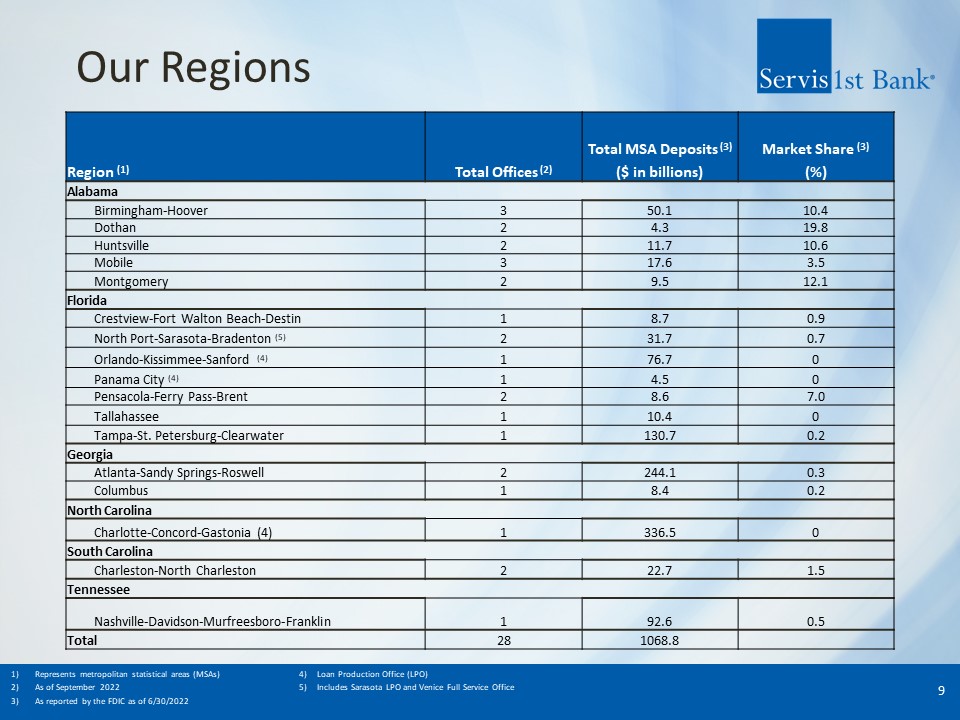
Our Regions 9 Represents metropolitan statistical areas (MSAs) 4) Loan Production Office (LPO) As
of September 2022 5) Includes Sarasota LPO and Venice Full Service Office As reported by the FDIC as of 6/30/2022 Region (1) Total Offices (2) Total MSA Deposits (3) Market Share (3) ($ in
billions) (%) Alabama Birmingham-Hoover 3 50.1 10.4 Dothan 2 4.3 19.8 Huntsville 2 11.7 10.6 Mobile 3 17.6 3.5 Montgomery 2 9.5 12.1 Florida Crestview-Fort Walton Beach-Destin 1 8.7 0.9 North
Port-Sarasota-Bradenton (5) 2 31.7 0.7 Orlando-Kissimmee-Sanford (4) 1 76.7 0 Panama City (4) 1 4.5 0 Pensacola-Ferry Pass-Brent 2 8.6 7.0 Tallahassee 1 10.4 0 Tampa-St.
Petersburg-Clearwater 1 130.7 0.2 Georgia Atlanta-Sandy Springs-Roswell 2 244.1 0.3 Columbus 1 8.4 0.2 North Carolina Charlotte-Concord-Gastonia (4) 1 336.5 0 South Carolina Charleston-North
Charleston 2 22.7 1.5 Tennessee Nashville-Davidson-Murfreesboro-Franklin 1 92.6 0.5 Total 28 1068.8
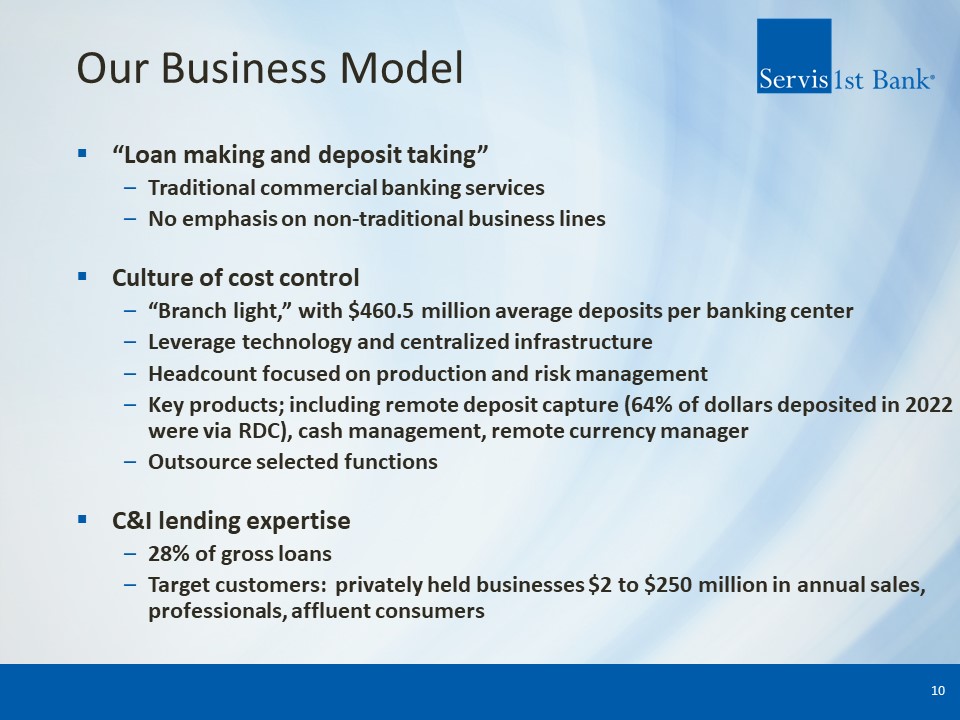
Our Business Model “Loan making and deposit taking” Traditional commercial banking services No
emphasis on non-traditional business lines Culture of cost control “Branch light,” with $460.5 million average deposits per banking center Leverage technology and centralized infrastructure Headcount focused on production and risk
management Key products; including remote deposit capture (64% of dollars deposited in 2022 were via RDC), cash management, remote currency manager Outsource selected functions C&I lending expertise 28% of gross loans Target
customers: privately held businesses $2 to $250 million in annual sales, professionals, affluent consumers 10
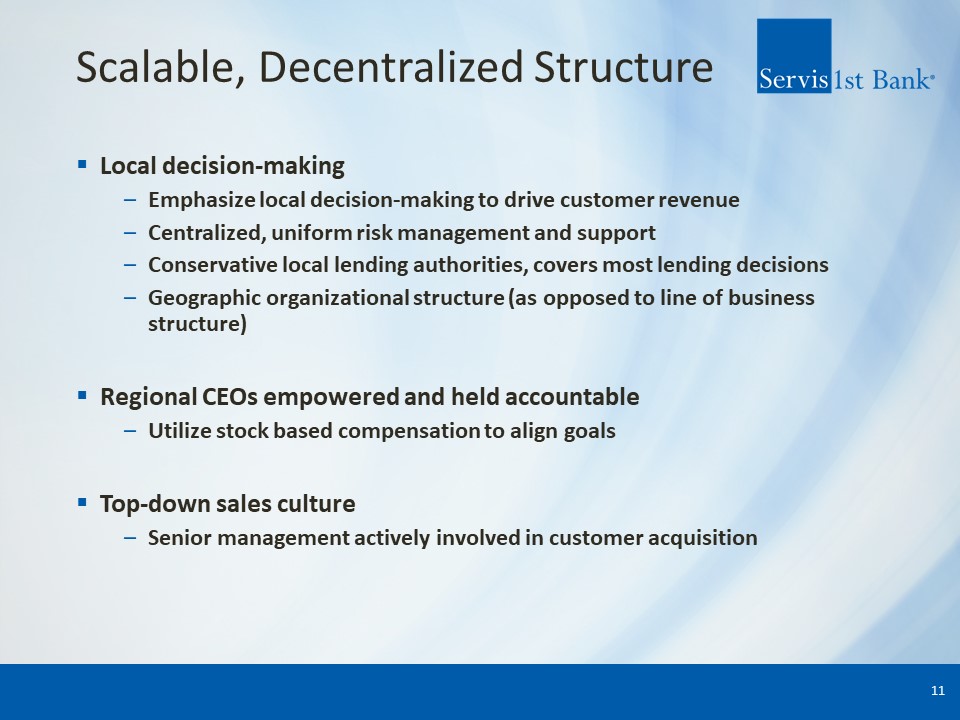
Scalable, Decentralized Structure Local decision-making Emphasize local decision-making to drive
customer revenue Centralized, uniform risk management and support Conservative local lending authorities, covers most lending decisions Geographic organizational structure (as opposed to line of business structure) Regional CEOs empowered
and held accountable Utilize stock based compensation to align goals Top-down sales culture Senior management actively involved in customer acquisition 11
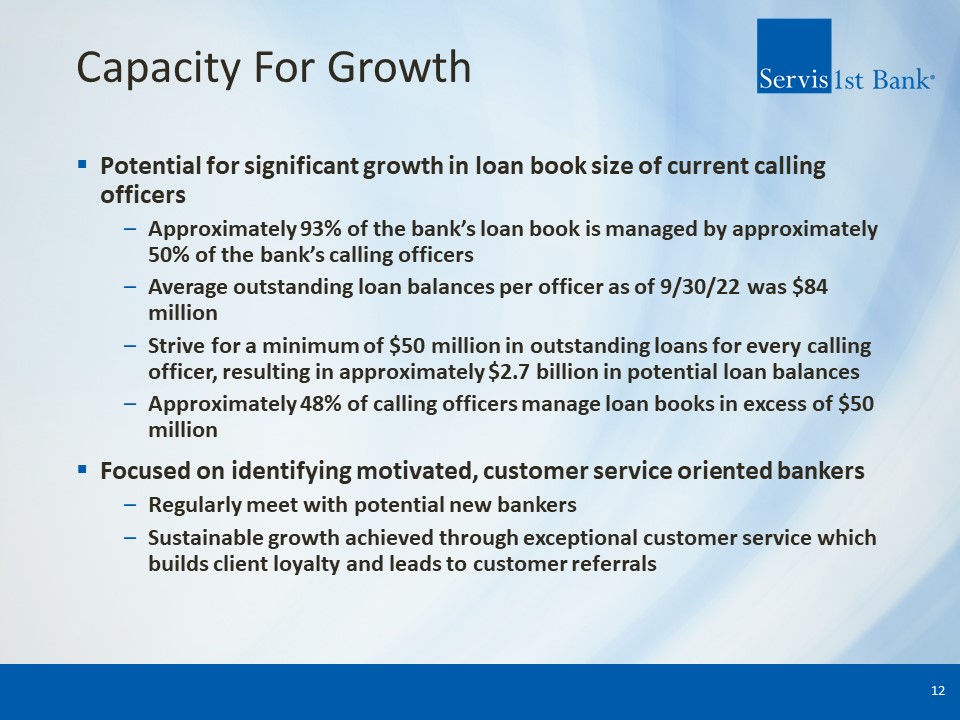
Capacity For Growth Potential for significant growth in loan book size of current calling
officers Approximately 93% of the bank’s loan book is managed by approximately 50% of the bank’s calling officers Average outstanding loan balances per officer as of 9/30/22 was $84 million Strive for a minimum of $50 million in
outstanding loans for every calling officer, resulting in approximately $2.7 billion in potential loan balances Approximately 48% of calling officers manage loan books in excess of $50 million Focused on identifying motivated, customer
service oriented bankers Regularly meet with potential new bankers Sustainable growth achieved through exceptional customer service which builds client loyalty and leads to customer referrals 12
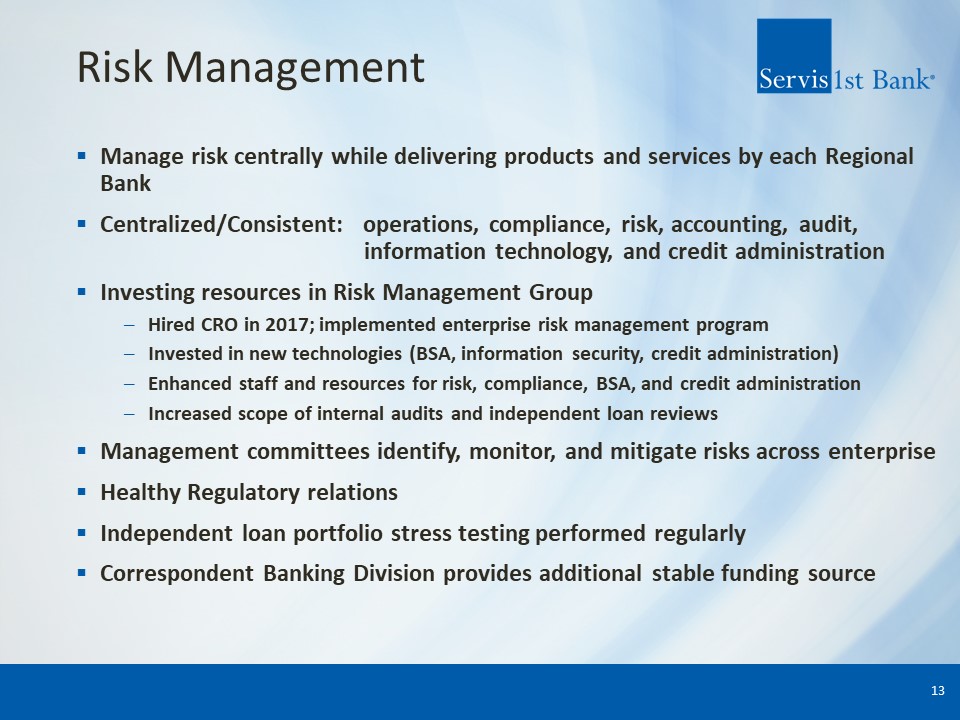
Risk Management Manage risk centrally while delivering products and services by each Regional
Bank Centralized/Consistent: operations, compliance, risk, accounting, audit, information technology, and credit administration Investing resources in Risk Management Group Hired CRO in 2017; implemented enterprise risk management
program Invested in new technologies (BSA, information security, credit administration) Enhanced staff and resources for risk, compliance, BSA, and credit administration Increased scope of internal audits and independent loan
reviews Management committees identify, monitor, and mitigate risks across enterprise Healthy Regulatory relations Independent loan portfolio stress testing performed regularly Correspondent Banking Division provides additional stable
funding source 13
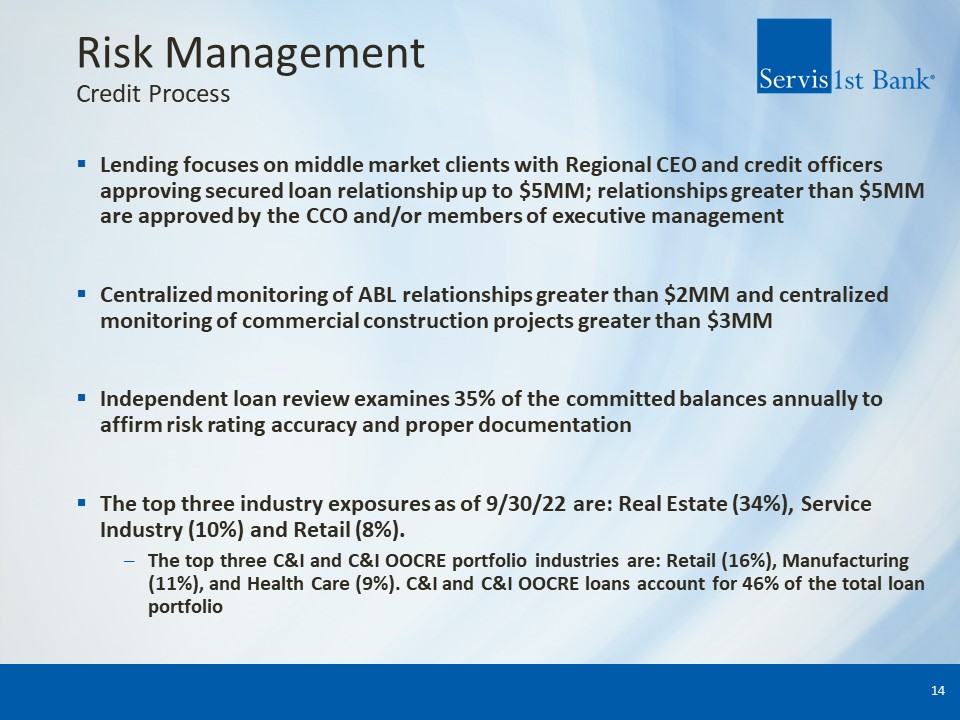
Risk ManagementCredit Process Lending focuses on middle market clients with Regional CEO and credit
officers approving secured loan relationship up to $5MM; relationships greater than $5MM are approved by the CCO and/or members of executive management Centralized monitoring of ABL relationships greater than $2MM and centralized monitoring
of commercial construction projects greater than $3MM Independent loan review examines 35% of the committed balances annually to affirm risk rating accuracy and proper documentation The top three industry exposures as of 9/30/22 are: Real
Estate (34%), Service Industry (10%) and Retail (8%). The top three C&I and C&I OOCRE portfolio industries are: Retail (16%), Manufacturing (11%), and Health Care (9%). C&I and C&I OOCRE loans account for 46% of the total
loan portfolio 14
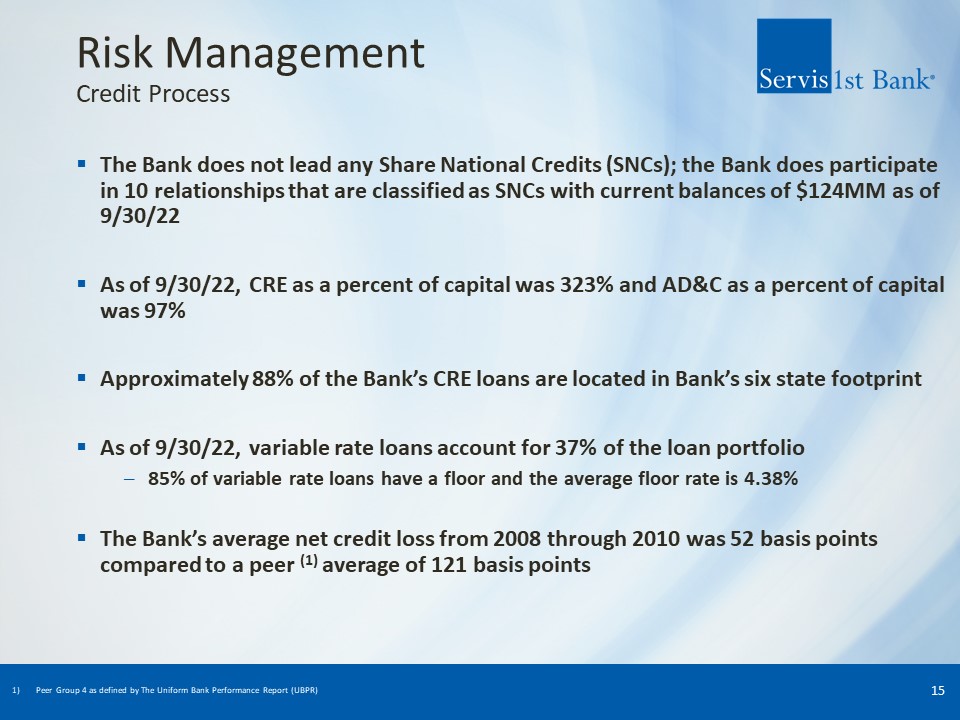
Risk ManagementCredit Process The Bank does not lead any Share National Credits (SNCs); the Bank does
participate in 10 relationships that are classified as SNCs with current balances of $124MM as of 9/30/22 As of 9/30/22, CRE as a percent of capital was 323% and AD&C as a percent of capital was 97% Approximately 88% of the Bank’s CRE
loans are located in Bank’s six state footprint As of 9/30/22, variable rate loans account for 37% of the loan portfolio 85% of variable rate loans have a floor and the average floor rate is 4.38% The Bank’s average net credit loss from
2008 through 2010 was 52 basis points compared to a peer (1) average of 121 basis points 15 Peer Group 4 as defined by The Uniform Bank Performance Report (UBPR)
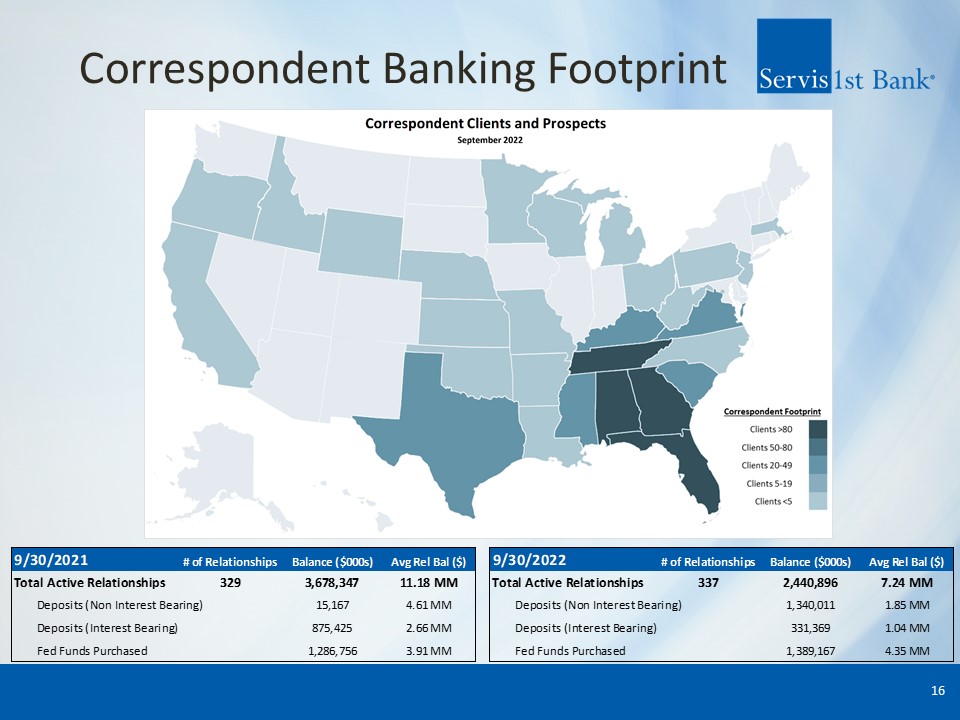
Correspondent Banking Footprint 16
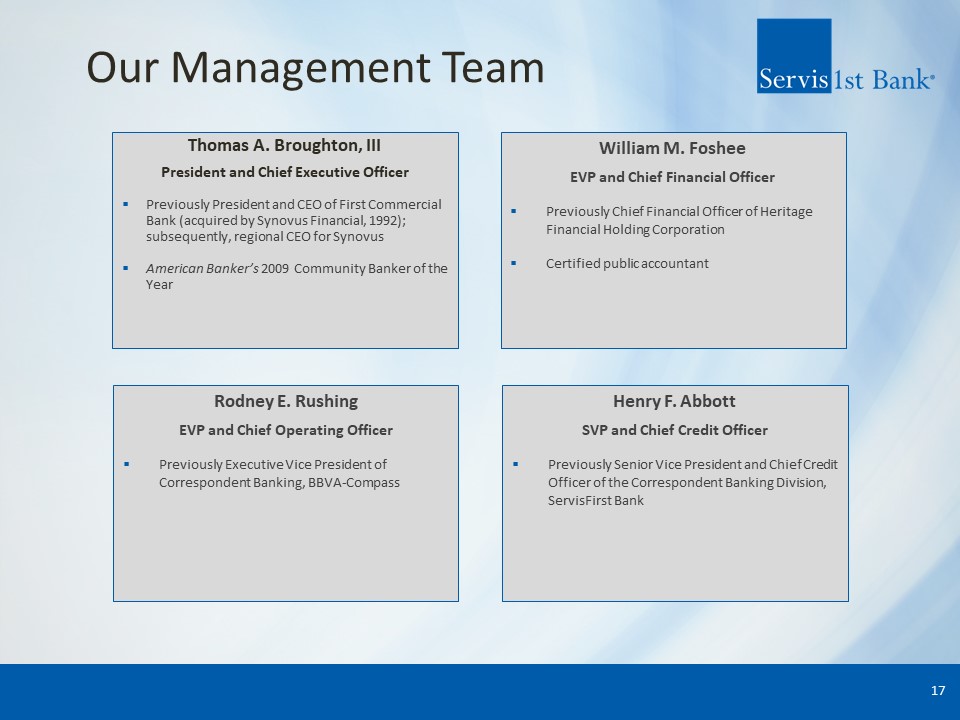
Our Management Team Thomas A. Broughton, III President and Chief Executive Officer Previously
President and CEO of First Commercial Bank (acquired by Synovus Financial, 1992); subsequently, regional CEO for Synovus American Banker’s 2009 Community Banker of the Year William M. Foshee EVP and Chief Financial Officer Previously
Chief Financial Officer of Heritage Financial Holding Corporation Certified public accountant Rodney E. Rushing EVP and Chief Operating Officer Previously Executive Vice President of Correspondent Banking, BBVA-Compass Henry F.
Abbott SVP and Chief Credit Officer Previously Senior Vice President and Chief Credit Officer of the Correspondent Banking Division, ServisFirst Bank 17
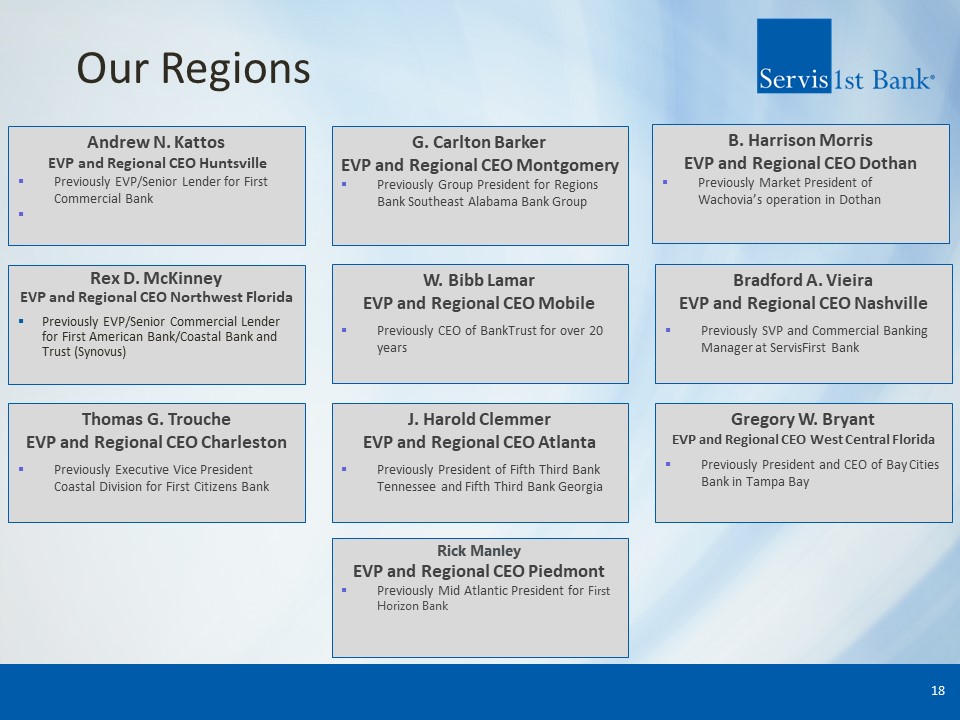
Our Regions Rex D. McKinney EVP and Regional CEO Northwest Florida Previously EVP/Senior Commercial
Lender for First American Bank/Coastal Bank and Trust (Synovus) Andrew N. Kattos EVP and Regional CEO Huntsville Previously EVP/Senior Lender for First Commercial Bank J. Harold Clemmer EVP and Regional CEO Atlanta Previously
President of Fifth Third Bank Tennessee and Fifth Third Bank Georgia W. Bibb Lamar EVP and Regional CEO Mobile Previously CEO of BankTrust for over 20 years G. Carlton Barker EVP and Regional CEO Montgomery Previously Group President
for Regions Bank Southeast Alabama Bank Group B. Harrison Morris EVP and Regional CEO Dothan Previously Market President of Wachovia’s operation in Dothan Gregory W. Bryant EVP and Regional CEO West Central Florida Previously President
and CEO of Bay Cities Bank in Tampa Bay Thomas G. Trouche EVP and Regional CEO Charleston Previously Executive Vice President Coastal Division for First Citizens Bank Bradford A. Vieira EVP and Regional CEO Nashville Previously SVP and
Commercial Banking Manager at ServisFirst Bank 18 Rick Manley EVP and Regional CEO Piedmont Previously Mid Atlantic President for First Horizon Bank

Financial Results
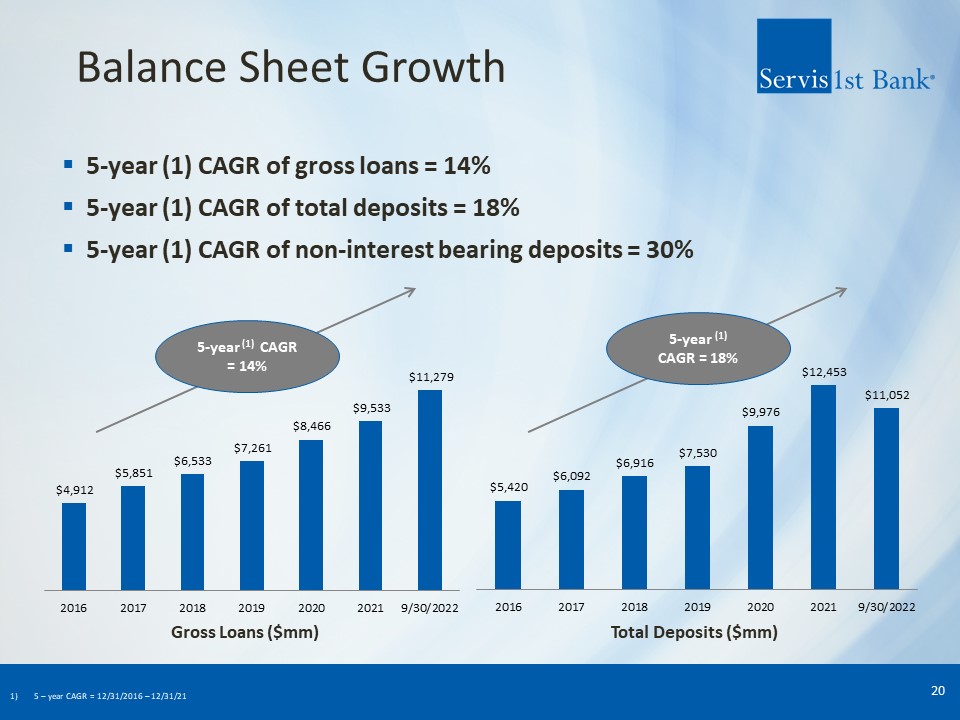
Balance Sheet Growth 5-year (1) CAGR of gross loans = 14% 5-year (1) CAGR of total deposits =
18% 5-year (1) CAGR of non-interest bearing deposits = 30% 20 5-year (1) CAGR = 14% 5-year (1) CAGR = 18% Gross Loans ($mm) Total Deposits ($mm) 5 – year CAGR = 12/31/2016 – 12/31/21
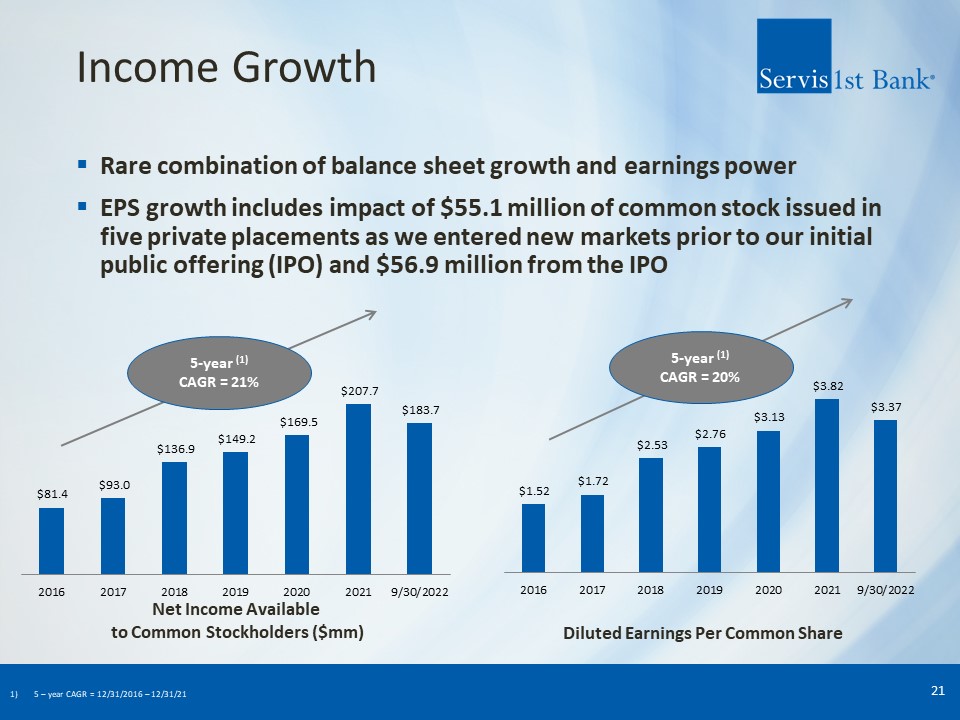
Income Growth Rare combination of balance sheet growth and earnings power EPS growth includes impact
of $55.1 million of common stock issued in five private placements as we entered new markets prior to our initial public offering (IPO) and $56.9 million from the IPO 21 5-year (1) CAGR = 21% 5-year (1) CAGR = 20% Net Income Available
to Common Stockholders ($mm) Diluted Earnings Per Common Share 5 – year CAGR = 12/31/2016 – 12/31/21
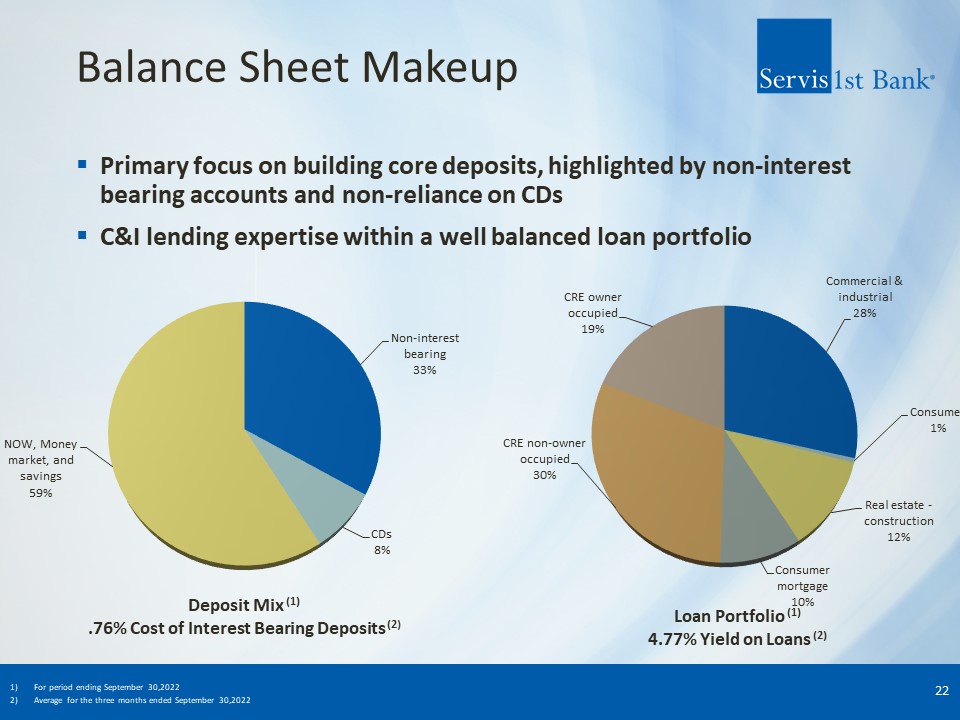
Balance Sheet Makeup Primary focus on building core deposits, highlighted by non-interest bearing
accounts and non-reliance on CDs C&I lending expertise within a well balanced loan portfolio 22 Deposit Mix (1) .76% Cost of Interest Bearing Deposits (2) Loan Portfolio (1) 4.77% Yield on Loans (2) For period ending September
30,2022 Average for the three months ended September 30,2022
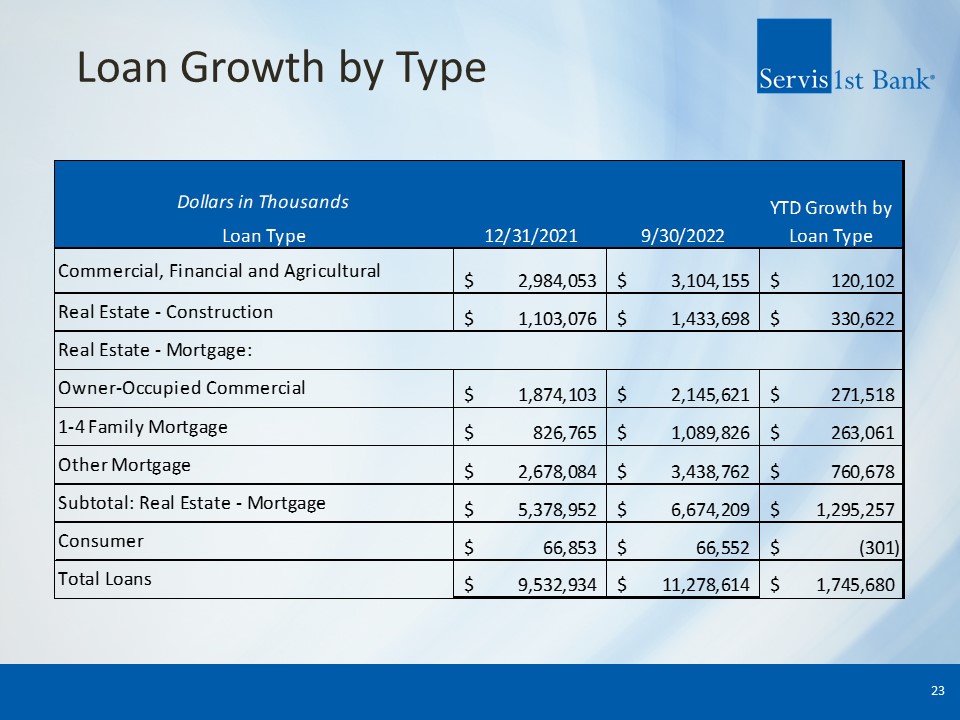
Loan Growth by Type 23
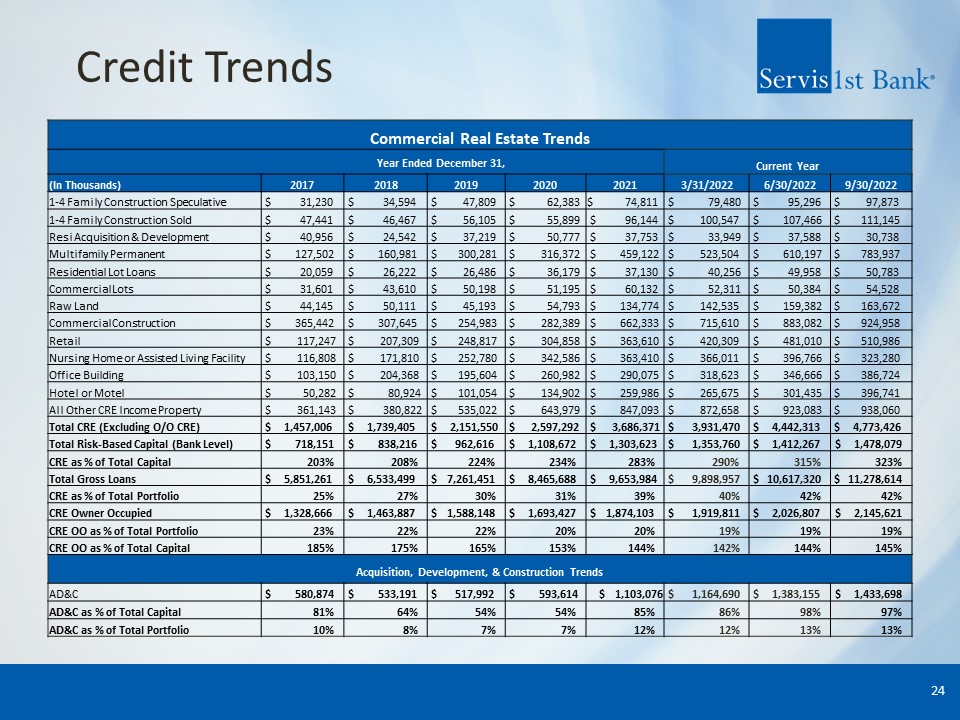
Commercial Real Estate Trends Year Ended December 31, Current Year (In
Thousands) 2017 2018 2019 2020 2021 3/31/2022 6/30/2022 9/30/2022 1-4 Family Construction Speculative $ 31,230 $ 34,594 $ 47,809 $ 62,383 $ 74,811 $ 79,480 $ 95,296 $ 97,873 1-4 Family Construction Sold $ 47,441
$ 46,467 $ 56,105 $ 55,899 $ 96,144 $ 100,547 $ 107,466 $ 111,145 Resi Acquisition & Development $ 40,956 $ 24,542 $ 37,219 $ 50,777 $ 37,753 $ 33,949 $ 37,588 $ 30,738 Multifamily Permanent $ 127,502
$ 160,981 $ 300,281 $ 316,372 $ 459,122 $ 523,504 $ 610,197 $ 783,937 Residential Lot Loans $ 20,059 $ 26,222 $ 26,486 $ 36,179 $ 37,130 $ 40,256 $ 49,958 $ 50,783 Commercial Lots $ 31,601 $ 43,610
$ 50,198 $ 51,195 $ 60,132 $ 52,311 $ 50,384 $ 54,528 Raw Land $ 44,145 $ 50,111 $ 45,193 $ 54,793 $ 134,774 $ 142,535 $ 159,382 $ 163,672 Commercial Construction $ 365,442 $ 307,645 $ 254,983 $
282,389 $ 662,333 $ 715,610 $ 883,082 $ 924,958 Retail $ 117,247 $ 207,309 $ 248,817 $ 304,858 $ 363,610 $ 420,309 $ 481,010 $ 510,986 Nursing Home or Assisted Living Facility $ 116,808 $ 171,810 $ 252,780 $
342,586 $ 363,410 $ 366,011 $ 396,766 $ 323,280 Office Building $ 103,150 $ 204,368 $ 195,604 $ 260,982 $ 290,075 $ 318,623 $ 346,666 $ 386,724 Hotel or Motel $ 50,282 $ 80,924 $ 101,054 $ 134,902 $
259,986 $ 265,675 $ 301,435 $ 396,741 All Other CRE Income Property $ 361,143 $ 380,822 $ 535,022 $ 643,979 $ 847,093 $ 872,658 $ 923,083 $ 938,060 Total CRE (Excluding O/O CRE) $ 1,457,006 $ 1,739,405 $
2,151,550 $ 2,597,292 $ 3,686,371 $ 3,931,470 $ 4,442,313 $ 4,773,426 Total Risk-Based Capital (Bank Level) $ 718,151 $ 838,216 $ 962,616 $ 1,108,672 $ 1,303,623 $ 1,353,760 $ 1,412,267 $ 1,478,079 CRE as % of
Total Capital 203% 208% 224% 234% 283% 290% 315% 323% Total Gross Loans $ 5,851,261 $ 6,533,499 $ 7,261,451 $ 8,465,688 $ 9,653,984 $ 9,898,957 $ 10,617,320 $ 11,278,614 CRE as % of Total
Portfolio 25% 27% 30% 31% 39% 40% 42% 42% CRE Owner Occupied $ 1,328,666 $ 1,463,887 $ 1,588,148 $ 1,693,427 $ 1,874,103 $ 1,919,811 $ 2,026,807 $ 2,145,621 CRE OO as % of Total
Portfolio 23% 22% 22% 20% 20% 19% 19% 19% CRE OO as % of Total Capital 185% 175% 165% 153% 144% 142% 144% 145% Acquisition, Development, & Construction Trends AD&C $ 580,874 $ 533,191 $ 517,992 $ 593,614
$ 1,103,076 $ 1,164,690 $ 1,383,155 $ 1,433,698 AD&C as % of Total Capital 81% 64% 54% 54% 85% 86% 98% 97% AD&C as % of Total Portfolio 10% 8% 7% 7% 12% 12% 13% 13% Credit Trends 24
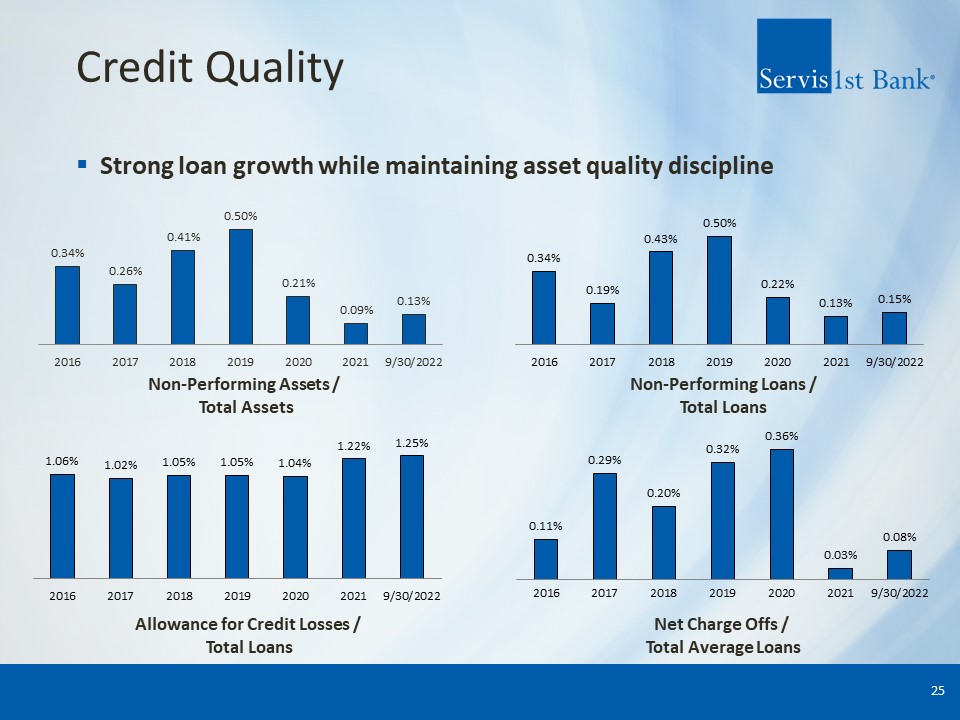
Credit Quality Strong loan growth while maintaining asset quality discipline 25 Allowance for Credit
Losses / Total Loans Net Charge Offs / Total Average Loans Non-Performing Assets / Total Assets Non-Performing Loans / Total Loans
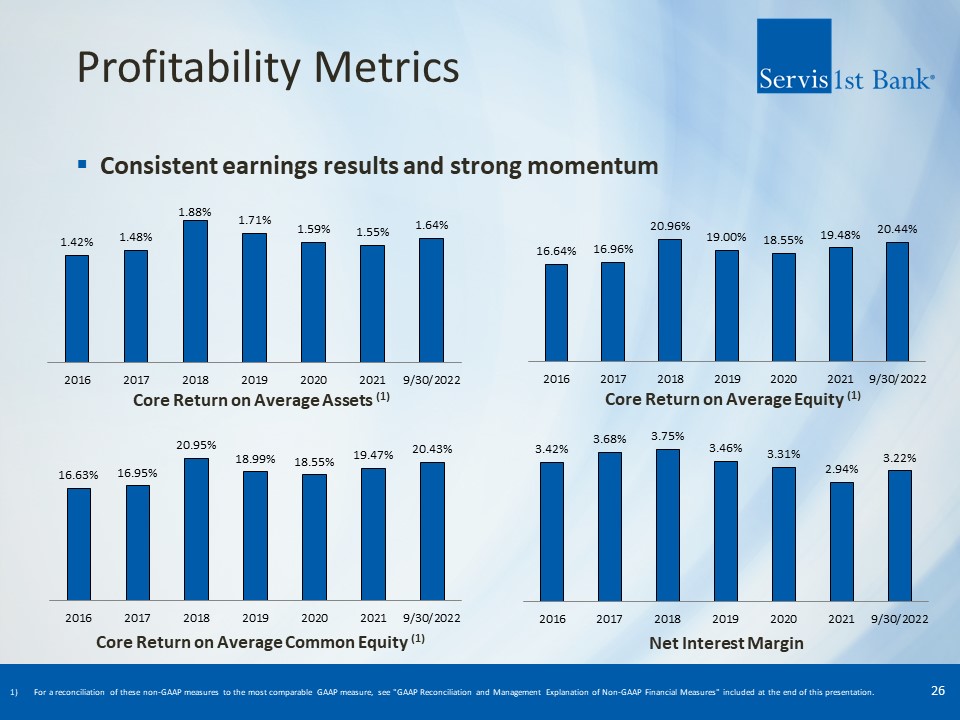
Profitability Metrics Consistent earnings results and strong momentum 26 Core Return on Average
Assets (1) Core Return on Average Equity (1) Core Return on Average Common Equity (1) Net Interest Margin For a reconciliation of these non-GAAP measures to the most comparable GAAP measure, see "GAAP Reconciliation and Management
Explanation of Non-GAAP Financial Measures" included at the end of this presentation.
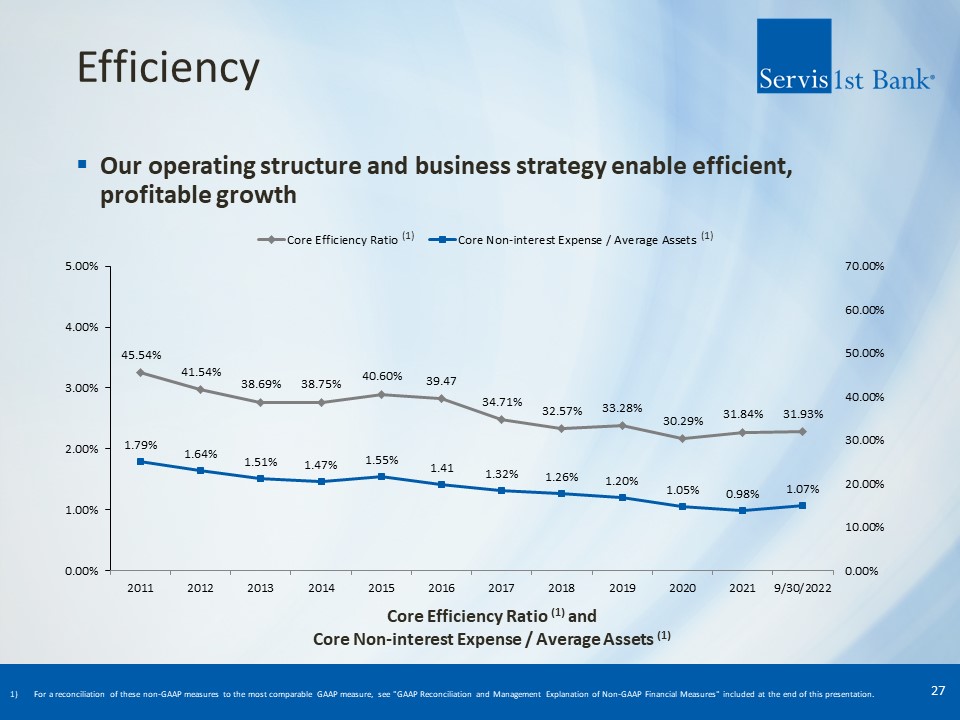
Efficiency Our operating structure and business strategy enable efficient, profitable growth 27 Core
Efficiency Ratio (1) and Core Non-interest Expense / Average Assets (1) (1) (1) For a reconciliation of these non-GAAP measures to the most comparable GAAP measure, see "GAAP Reconciliation and Management Explanation of Non-GAAP Financial
Measures" included at the end of this presentation.
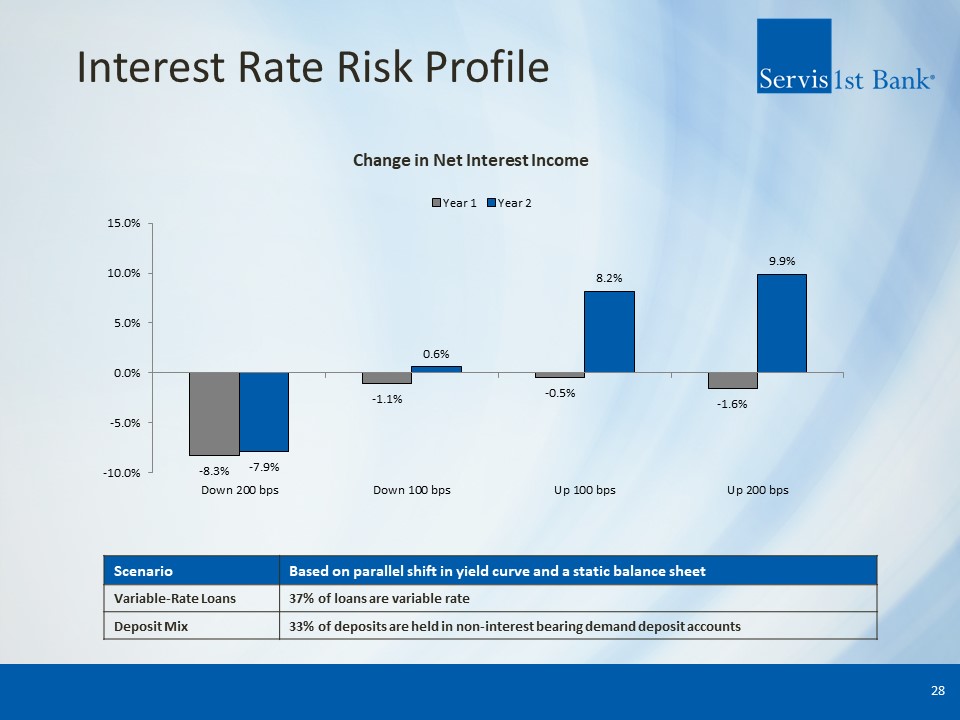
Interest Rate Risk Profile 28 Change in Net Interest Income Scenario Based on parallel shift in
yield curve and a static balance sheet Variable-Rate Loans 37% of loans are variable rate Deposit Mix 33% of deposits are held in non-interest bearing demand deposit accounts
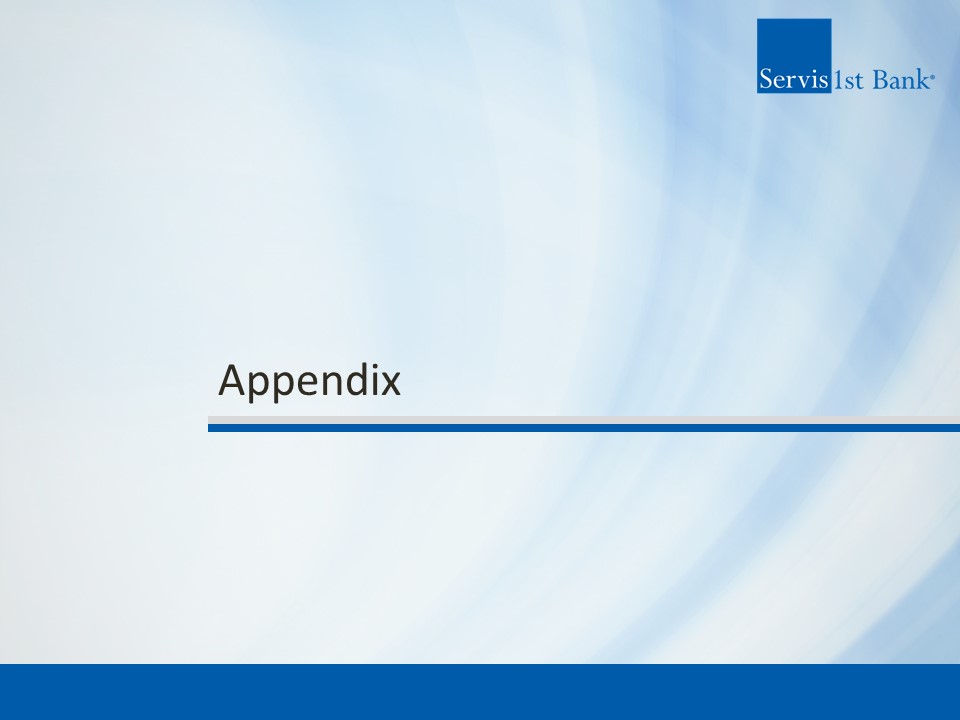
Appendix
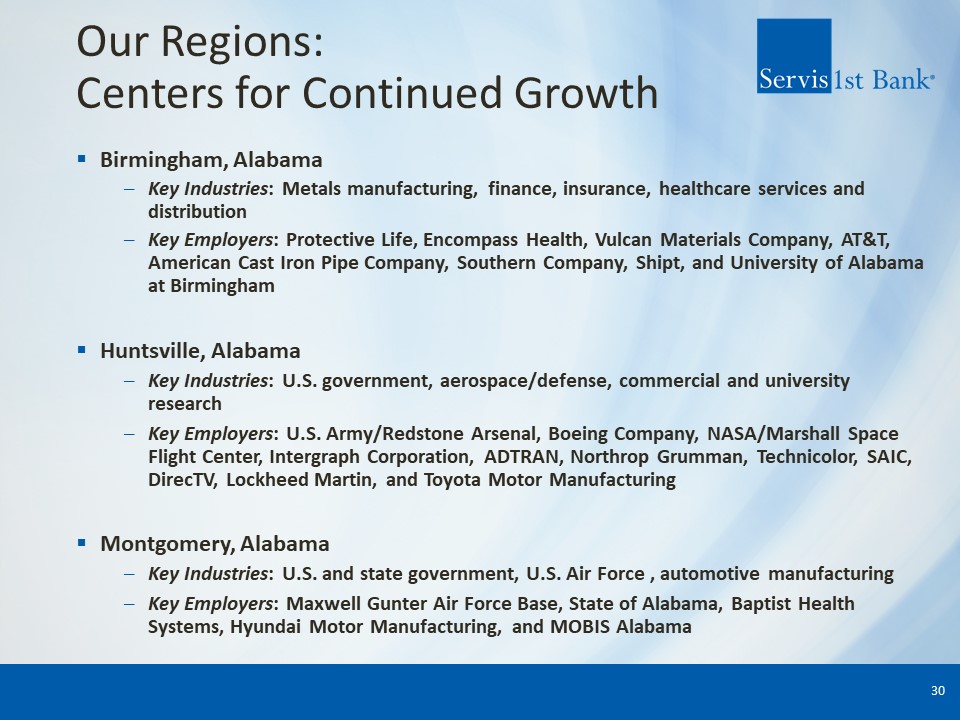
Our Regions: Centers for Continued Growth Birmingham, Alabama Key Industries: Metals manufacturing,
finance, insurance, healthcare services and distribution Key Employers: Protective Life, Encompass Health, Vulcan Materials Company, AT&T, American Cast Iron Pipe Company, Southern Company, Shipt, and University of Alabama at
Birmingham Huntsville, Alabama Key Industries: U.S. government, aerospace/defense, commercial and university research Key Employers: U.S. Army/Redstone Arsenal, Boeing Company, NASA/Marshall Space Flight Center, Intergraph Corporation,
ADTRAN, Northrop Grumman, Technicolor, SAIC, DirecTV, Lockheed Martin, and Toyota Motor Manufacturing Montgomery, Alabama Key Industries: U.S. and state government, U.S. Air Force , automotive manufacturing Key Employers: Maxwell Gunter
Air Force Base, State of Alabama, Baptist Health Systems, Hyundai Motor Manufacturing, and MOBIS Alabama 30
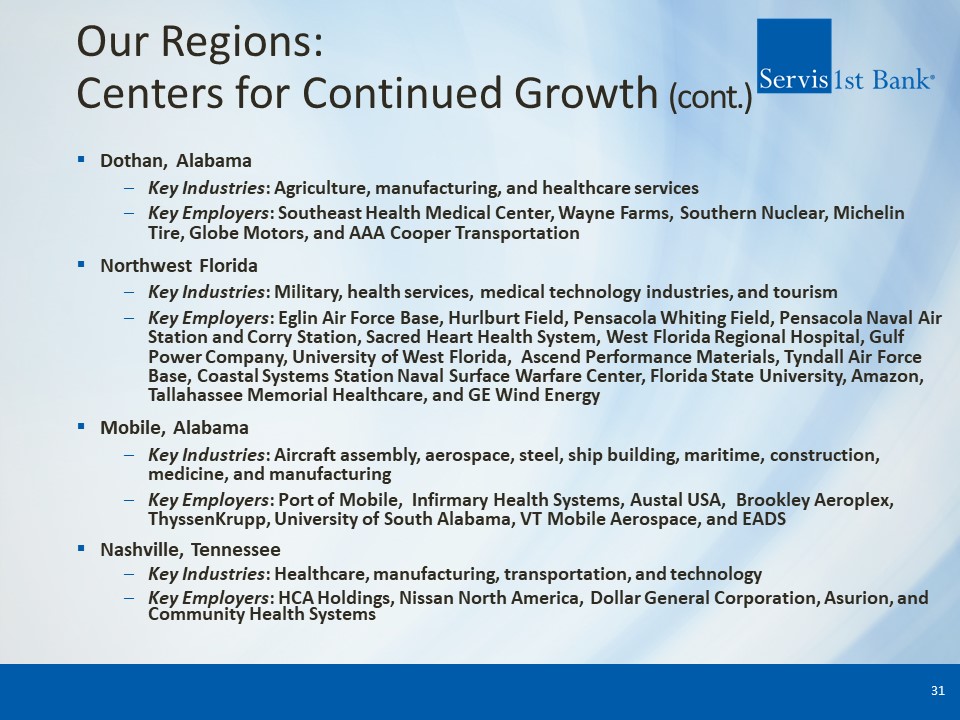
Our Regions: Centers for Continued Growth (cont.) Dothan, Alabama Key Industries: Agriculture,
manufacturing, and healthcare services Key Employers: Southeast Health Medical Center, Wayne Farms, Southern Nuclear, Michelin Tire, Globe Motors, and AAA Cooper Transportation Northwest Florida Key Industries: Military, health services,
medical technology industries, and tourism Key Employers: Eglin Air Force Base, Hurlburt Field, Pensacola Whiting Field, Pensacola Naval Air Station and Corry Station, Sacred Heart Health System, West Florida Regional Hospital, Gulf Power
Company, University of West Florida, Ascend Performance Materials, Tyndall Air Force Base, Coastal Systems Station Naval Surface Warfare Center, Florida State University, Amazon, Tallahassee Memorial Healthcare, and GE Wind Energy Mobile,
Alabama Key Industries: Aircraft assembly, aerospace, steel, ship building, maritime, construction, medicine, and manufacturing Key Employers: Port of Mobile, Infirmary Health Systems, Austal USA, Brookley Aeroplex, ThyssenKrupp, University
of South Alabama, VT Mobile Aerospace, and EADS Nashville, Tennessee Key Industries: Healthcare, manufacturing, transportation, and technology Key Employers: HCA Holdings, Nissan North America, Dollar General Corporation, Asurion, and
Community Health Systems 31
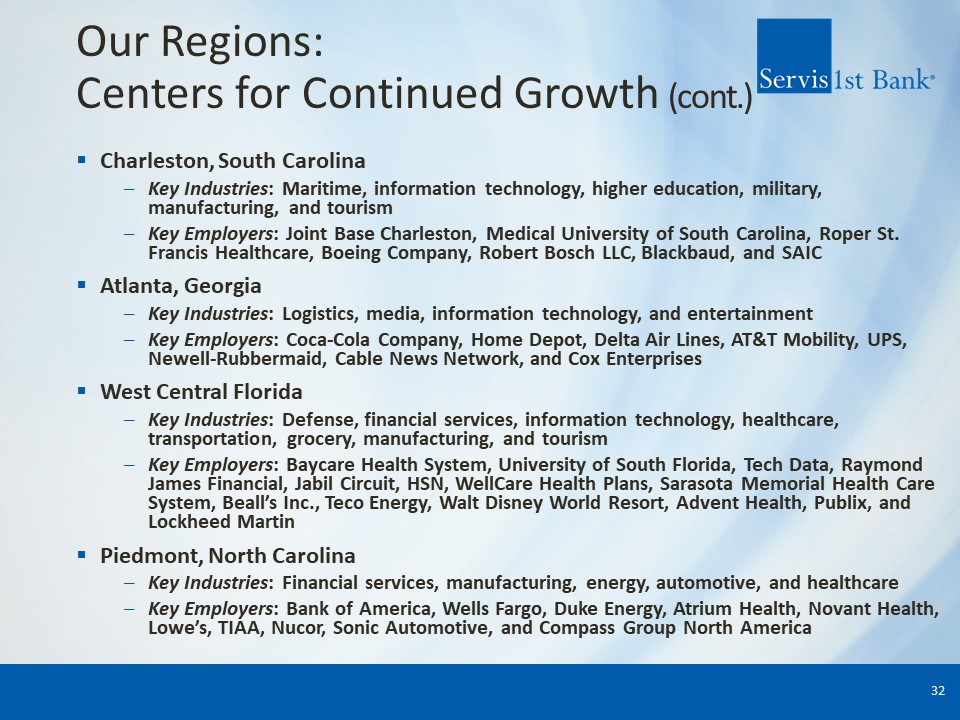
Our Regions: Centers for Continued Growth (cont.) Charleston, South Carolina Key Industries:
Maritime, information technology, higher education, military, manufacturing, and tourism Key Employers: Joint Base Charleston, Medical University of South Carolina, Roper St. Francis Healthcare, Boeing Company, Robert Bosch LLC, Blackbaud,
and SAIC Atlanta, Georgia Key Industries: Logistics, media, information technology, and entertainment Key Employers: Coca-Cola Company, Home Depot, Delta Air Lines, AT&T Mobility, UPS, Newell-Rubbermaid, Cable News Network, and Cox
Enterprises West Central Florida Key Industries: Defense, financial services, information technology, healthcare, transportation, grocery, manufacturing, and tourism Key Employers: Baycare Health System, University of South Florida, Tech
Data, Raymond James Financial, Jabil Circuit, HSN, WellCare Health Plans, Sarasota Memorial Health Care System, Beall’s Inc., Teco Energy, Walt Disney World Resort, Advent Health, Publix, and Lockheed Martin Piedmont, North Carolina Key
Industries: Financial services, manufacturing, energy, automotive, and healthcare Key Employers: Bank of America, Wells Fargo, Duke Energy, Atrium Health, Novant Health, Lowe’s, TIAA, Nucor, Sonic Automotive, and Compass Group North
America 32
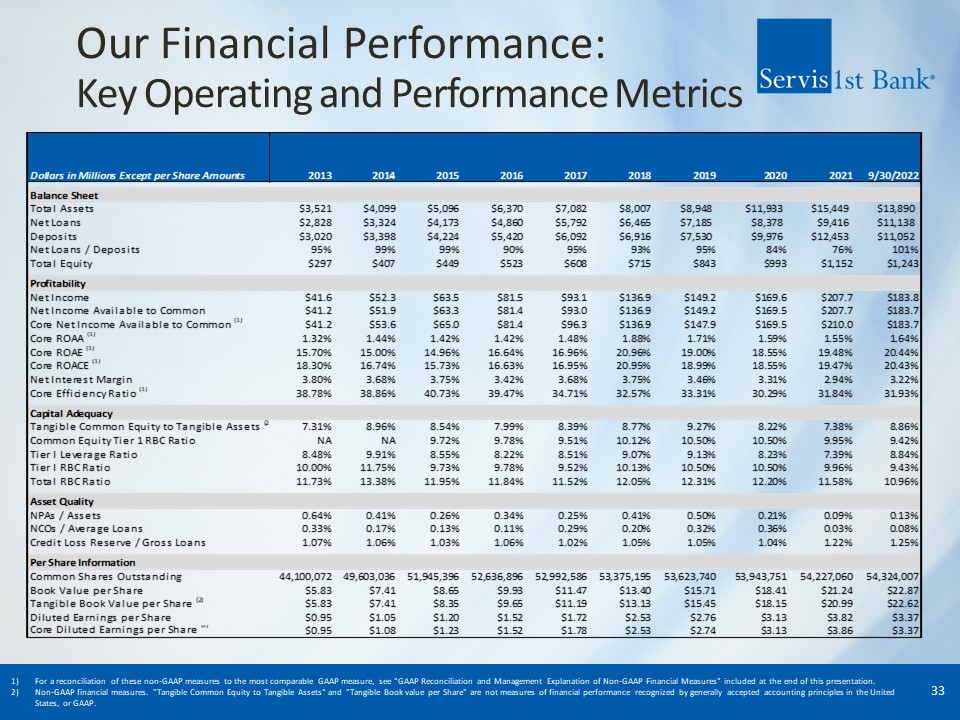
Our Financial Performance:Key Operating and Performance Metrics 33 For a reconciliation of these
non-GAAP measures to the most comparable GAAP measure, see "GAAP Reconciliation and Management Explanation of Non-GAAP Financial Measures" included at the end of this presentation. Non-GAAP financial measures. "Tangible Common Equity to
Tangible Assets" and "Tangible Book value per Share" are not measures of financial performance recognized by generally accepted accounting principles in the United States, or GAAP.
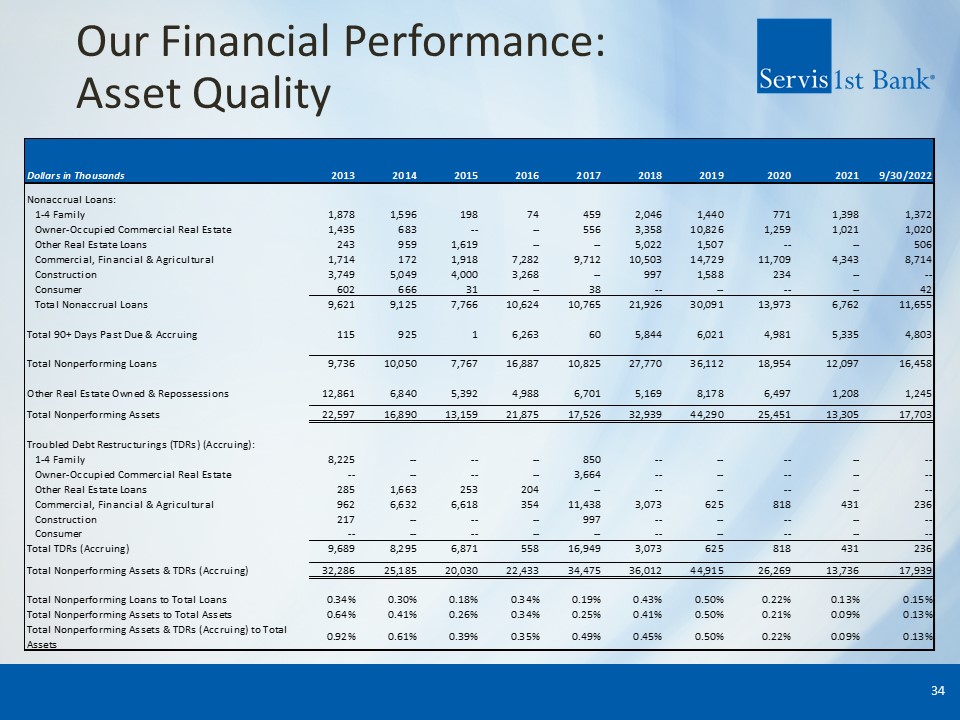
Our Financial Performance:Asset Quality 34
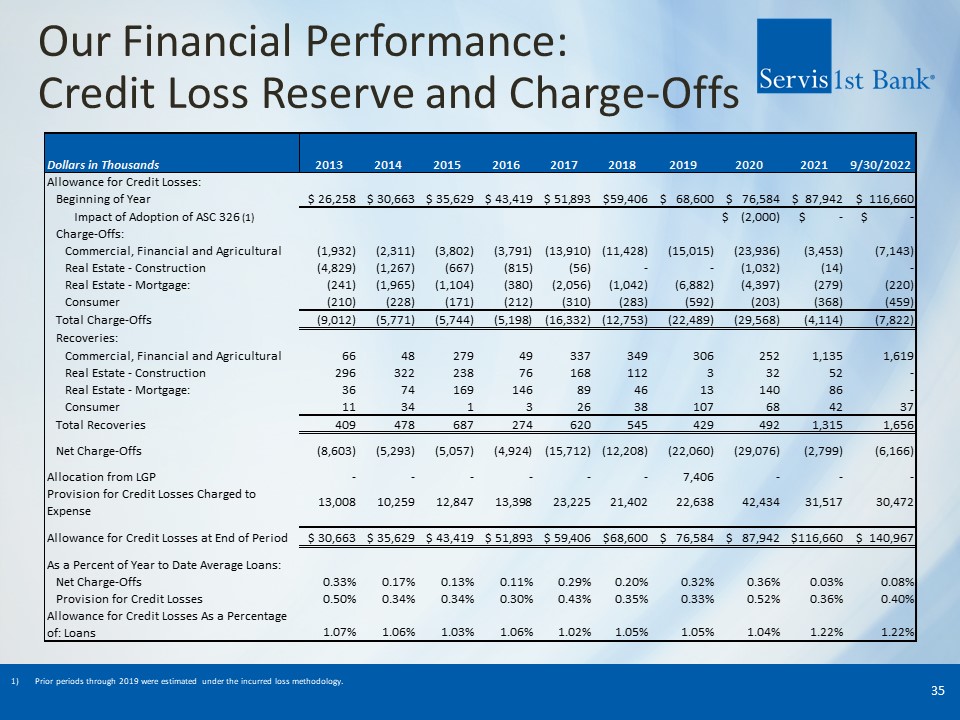
Our Financial Performance:Credit Loss Reserve and Charge-Offs 35 Prior periods through 2019 were
estimated under the incurred loss methodology.
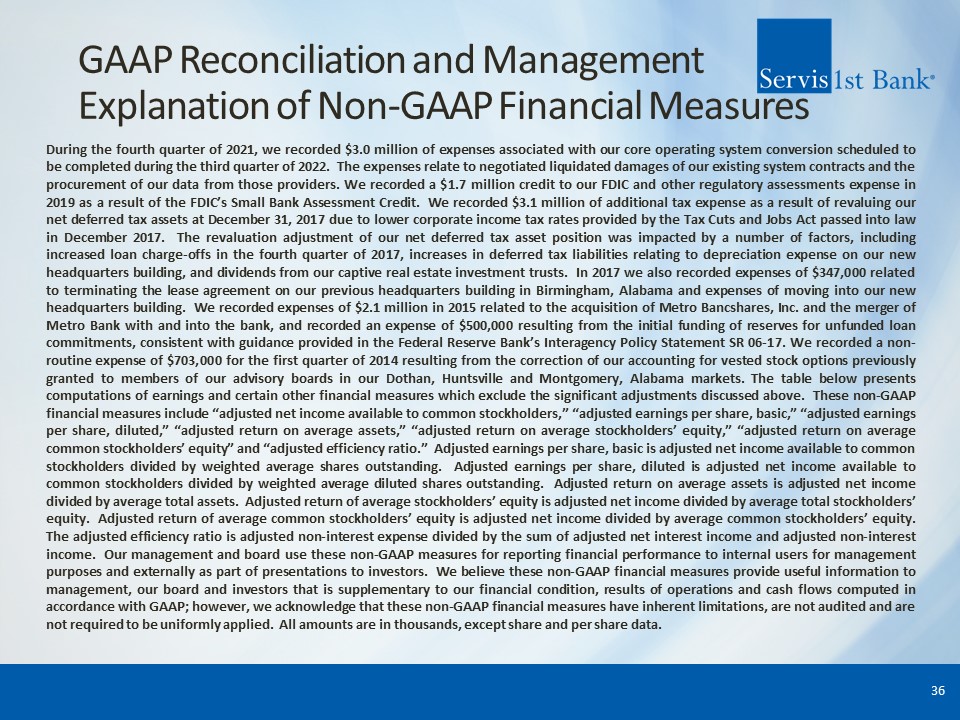
GAAP Reconciliation and Management Explanation of Non-GAAP Financial Measures During the fourth
quarter of 2021, we recorded $3.0 million of expenses associated with our core operating system conversion scheduled to be completed during the third quarter of 2022. The expenses relate to negotiated liquidated damages of our existing system
contracts and the procurement of our data from those providers. We recorded a $1.7 million credit to our FDIC and other regulatory assessments expense in 2019 as a result of the FDIC’s Small Bank Assessment Credit. We recorded $3.1 million of
additional tax expense as a result of revaluing our net deferred tax assets at December 31, 2017 due to lower corporate income tax rates provided by the Tax Cuts and Jobs Act passed into law in December 2017. The revaluation adjustment of our
net deferred tax asset position was impacted by a number of factors, including increased loan charge-offs in the fourth quarter of 2017, increases in deferred tax liabilities relating to depreciation expense on our new headquarters building,
and dividends from our captive real estate investment trusts. In 2017 we also recorded expenses of $347,000 related to terminating the lease agreement on our previous headquarters building in Birmingham, Alabama and expenses of moving into
our new headquarters building. We recorded expenses of $2.1 million in 2015 related to the acquisition of Metro Bancshares, Inc. and the merger of Metro Bank with and into the bank, and recorded an expense of $500,000 resulting from the
initial funding of reserves for unfunded loan commitments, consistent with guidance provided in the Federal Reserve Bank’s Interagency Policy Statement SR 06-17. We recorded a non-routine expense of $703,000 for the first quarter of 2014
resulting from the correction of our accounting for vested stock options previously granted to members of our advisory boards in our Dothan, Huntsville and Montgomery, Alabama markets. The table below presents computations of earnings and
certain other financial measures which exclude the significant adjustments discussed above. These non-GAAP financial measures include “adjusted net income available to common stockholders,” “adjusted earnings per share, basic,” “adjusted
earnings per share, diluted,” “adjusted return on average assets,” “adjusted return on average stockholders’ equity,” “adjusted return on average common stockholders’ equity” and “adjusted efficiency ratio.” Adjusted earnings per share, basic
is adjusted net income available to common stockholders divided by weighted average shares outstanding. Adjusted earnings per share, diluted is adjusted net income available to common stockholders divided by weighted average diluted shares
outstanding. Adjusted return on average assets is adjusted net income divided by average total assets. Adjusted return of average stockholders’ equity is adjusted net income divided by average total stockholders’ equity. Adjusted return of
average common stockholders’ equity is adjusted net income divided by average common stockholders’ equity. The adjusted efficiency ratio is adjusted non-interest expense divided by the sum of adjusted net interest income and adjusted
non-interest income. Our management and board use these non-GAAP measures for reporting financial performance to internal users for management purposes and externally as part of presentations to investors. We believe these non-GAAP financial
measures provide useful information to management, our board and investors that is supplementary to our financial condition, results of operations and cash flows computed in accordance with GAAP; however, we acknowledge that these non-GAAP
financial measures have inherent limitations, are not audited and are not required to be uniformly applied. All amounts are in thousands, except share and per share data. 36
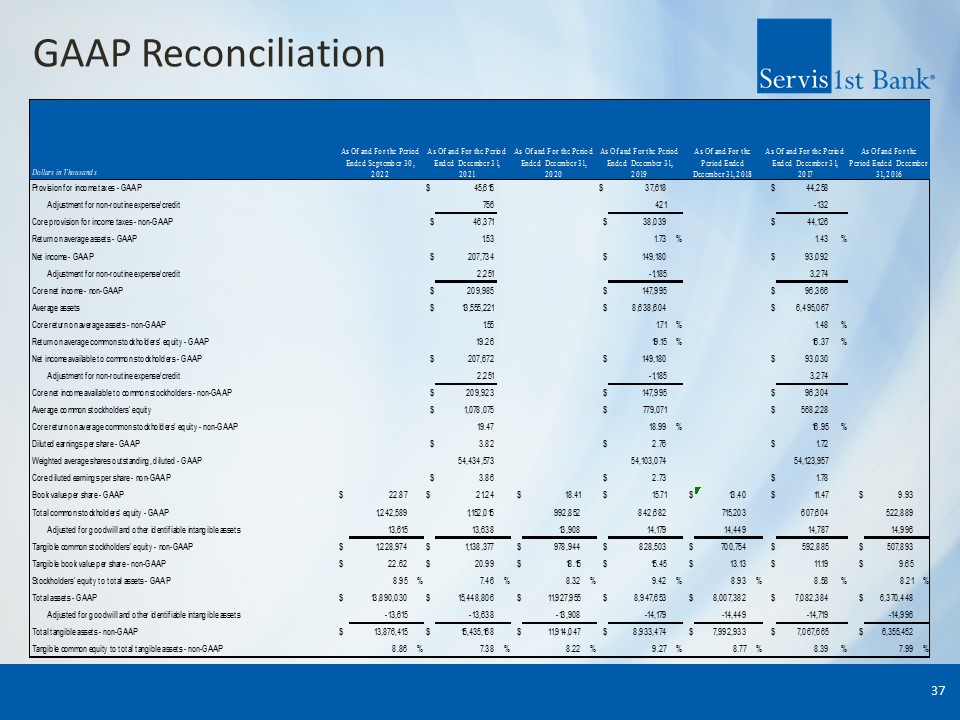
GAAP Reconciliation 37